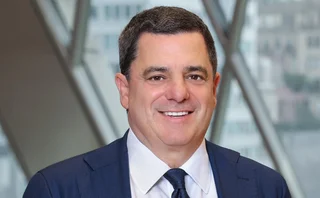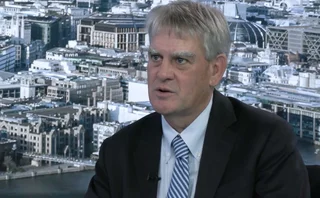
Quant of the year: Hans Buehler
Risk Awards 2022: Architect of deep hedging aims to supplant orthodox models with method based purely on data

Hans Buehler started to think of a way to hedge derivatives that would do away with much of quant finance theory as far back as 2008.
In place of models like Black-Scholes, Heston or local volatility, Buehler, who heads equities and investor services quantitative research at JP Morgan, imagined banks could hedge derivatives using methods based on data alone. His idea was to lean on machine learning techniques to determine what hedges might work in future based on what had worked in the past.
The Greeks – delta, vega, theta and so on – which measure the theoretical sensitivity of derivatives to market forces and form the foundation of derivatives trading, would hold a marginal role, if any, in Buehler’s conception.
Banks might use the Greeks to set boundaries for Buehler’s new-style trading engines. But the machines would be able to run without them. In the revised order of things, the use of parametric models would be superseded by a Greek-free, model-free approach.
It’s a bold idea and has polarised opinion. Buehler himself says: “Half of people don’t believe in it. The other half believe in it too much.”
Consensus is coming round to his view, though. Today, Buehler’s research on statistical hedging and deep hedging have drawn a band of followers across industry and academia.
“He has a network of people around him – traders, risk managers, academics – all of whom have bought into his vision of how things are going to be in the future,” says Jim Gatheral, professor of mathematics at Baruch College, City University of New York.
Advances by Buehler and his team in hedging options have enabled JP Morgan to put the data-driven approach into production. Since 2018, the bank has been using Flow Trader – a first cut of its data-driven hedging algorithm – to hedge vanilla index option books on the S&P 500 and Euro Stoxx.
He has a network of people around him – traders, risk managers, academics – all of whom have bought into his vision of how things are going to be in the future
Jim Gatheral, Baruch College, City University of New York
Today, 70% of Euro Stoxx flow options trading at the bank is quoted and hedged by machine, according to Jason Sippel, head of global equities, with human traders simply eyeballing instructions before they are executed.
Last October, JP Morgan began testing a more advanced version of the engine to trade books of European cliquet options – instruments with a path-dependent payoff that reset on a sequence of predetermined dates. While Flow Trader relies on statistical regression, the deep neural network used to trade cliquets learns hedging strategies iteratively from vast amounts of simulated data.
For now, that algorithm trades only against the bank’s flow desk, which hedges in the market. The firm aims, though, to go live with external trading later this year. “We are in the foothills of that initiative,” says Sippel.
Stats the way
Buehler’s detailed work on the idea of ‘statistical hedging’ began when efforts at JP Morgan to automate hedging using classical models fell flat.
“We realised relatively quickly it would not work,” Buehler said of that project on a Risk.net webcast in 2019. The algorithm was unable to apply the ad hoc adjustments traders make to handle anomalies in pricing, such as volatility skew that classical models fail to account for.
The quants, though, found that a rudimentary alternative – regressing the time series of exotics prices against a time series of vanilla options to learn how to replicate one with the other – performed surprisingly well.
Buehler built on that basic notion and presented his developed work on statistical hedging at industry conferences in 2013 and 2014. He wrote a working paper on the theme in 2017.
Statistical hedging was only a forerunner, though, to Buehler’s true objective: a machine that could learn how to form replicating portfolios for complex over-the-counter derivatives, for which payoffs might be path-dependent and data scarce.
Buehler dubbed it “deep hedging” – and he went on to describe such a machine in a 2019 paper of that title. The paper has garnered more than 10,000 views and downloads across different sites since publication. A LinkedIn post of a presentation he gave on the topic last year was viewed 33,000 times.
Deep hedging extends the principles applied in statistical hedging but uses a deep neural network to learn hedging strategies iteratively from the data, through hundreds of thousands of simulations.
The neural network ingests data from prices but can also contain information such as trading signals, news analytics or previous hedging decisions – “quantitative information a human trader might use, in true machine learning fashion”, the paper states.
Unlike classical models, which generate hedging strategies that traders must adjust, the data-driven engine automatically accounts for market frictions such as transaction costs, liquidity constraints, bid/ask spreads, market impact and so on.
To apply deep hedging required one additional step, however.
The neural network demands far more data for training than exists. So, Buehler and his JP Morgan colleagues built a market generator to create simulated but realistic market data to train the model on.
Last year, Buehler detailed the firm’s work using signatures – a way of encoding time series data that captures how the data evolves through time – to build a data generator that replicates features of real markets, including correlations.
For that research, Buehler teamed up with fellow JP Morgan quant Ben Wood, Blanka Horvath, professor of financial mathematics at TU Munich, Imanol Perez of Oxford University and Terry Lyons, the professor at Oxford University who introduced the concept of signatures. The aim of the research project was to overcome the paucity of data for training the engine. Signatures, thanks to their ability to converge to a stable result with a relatively small training dataset, proved perfectly suited to the task.
“We calculate the signature on the compressed state – the machine learning principal component analysis state, if you want – of the local volatility surface,” Buehler explains.
Using a variational autoencoder – a form of machine learning that reduces the complexity of high-dimension problems, such as those involving multiple risk factors – the quants can create multiple simulated time series, which are used to train the deep hedging engine.
In another working paper also released last year, JP Morgan quants propose a way to eliminate the ‘drift’ the machine would otherwise learn from observing a market that trends. Essentially, this is a way to stop the engine thinking markets that have drifted higher in the recent past always will. “You need to make sure the machine understands that’s an estimation error,” Buehler says.
A deep hedging engine trained on biased data will learn to make directional bets, he explains. “That’s not what you want. And even if you do want it, you probably want to split the hedge from the directional strategy,” Buehler says.
Dollars and paradigms
In JP Morgan’s own testing, deep hedging of exotic options performed well against challenger models, Buehler says. “It looks good, very good, in fact” – though he cautions that out-of-sample performance remains as yet untested.
Because the method implicitly accounts for transaction costs and market frictions, it promises more accurate and therefore cheaper hedging.
Analysis by Beacon Platform, a financial technology company, estimated transaction cost savings of up to 80% and a reduction in hedging error by up to 90% when hedging commodities books using data-driven hedging. An IBM-led project in similar tests of the approach applied to equity portfolios achieved as much as a 30% improvement in accuracy and double-digit reduction in transaction costs.
Hans said to do something completely new, completely data-driven,” she says. “At the time I thought it was crazy, it wouldn’t work
Blanka Horvath, TU Munich
Buehler’s dismantling of options theory will take some getting used to. Horvath recalls her time with the JP Morgan team in 2018. “Hans said to do something completely new, completely data-driven,” she says. “At the time I thought it was crazy, it wouldn’t work.”
It’s a step-change for traders, too. “This is a top-level reimagining of what we want trading to be,” Sippel says. “A complete reinvention of how derivatives books are traded.”
Hedging strategies become standardised rather than individual traders applying “heterogeneous approaches to risk-managing a book”, Sippel says. Traders no longer are tied up for long tracts of the day manually quoting or making hedging decisions based on client flow “with the IP effectively in their head as to how they price and risk-manage”.
Thanks to Flow Trader, JP Morgan’s traders already spend more of their day speaking to clients. “The role of trading changes,” Sippel says. “It frees them up.” Over the long term, that should make the bank more efficient.
Code-cracker
Buehler’s working habits, according to those who know him, evoke Thomas Edison’s description of genius: 1% inspiration, 99% perspiration. His work ethic is “pretty insane”, says Horvath, who has collaborated with Buehler on several projects. “He follows a tight schedule during the day. Then you get three or four emails from him when he has been working on the code overnight and has figured something out.”
He has an unflinching belief in what he’s doing, peers say, and a willingness to drum out lines of code as much as talk theory at industry events. “He’s the right mix of pure quant and a commercial animal,” Sippel says.
Buehler will be a headline speaker at the Bachelier Finance Society conference in June, one of the biggest events in the finance academic calendar. He is the only industry speaker on the plenary roster. (Keynoting at that event is Nobel laureate Robert Merton from MIT, an author of the pricing theory that Buehler is busy supplanting.)
In December 2021, Buehler was appointed visiting professor at the Technical University of Munich, where he will run a programme of seminars on machine learning in finance.
All this is in addition to his day job at JP Morgan. Buehler joined the bank in June 2008 to head Asia equities quantitative research, later moving to head quant research, first in Europe and then firm-wide.
In 2018, he took on the additional role of global head of equities data analytics, automation and optimisation, leading a drive to automate and increase the use of data in JP Morgan’s equities business, including clearing, prime brokerage, cash trading and derivatives.
More is to come from Buehler and his team. A project in development dubbed Trex applies deep hedging to intraday delta hedging.
The firm has created, and filed a patent for, a version of Flow Trader using dynamic programming to learn optimal hedging strategies over horizons of several days.
Other investment banks are watching closely. As are academics. “He’s basically sparked a whole strand of research,” Gatheral says. “It’s a fundamental contribution.”
Mathieu Rosenbaum, a professor at École Polytechnique outside Paris, says a fifth of the interns from the university’s master’s programme are working in some way on deep hedging.
Buehler has “brought something new [to the field]”, Rosenbaum says. “Everybody is looking at deep hedging. He’s opened a lot of directions for research both for academics and for practitioners.”
The research, Rosenbaum says, “is going to last for years”.
Only users who have a paid subscription or are part of a corporate subscription are able to print or copy content.
To access these options, along with all other subscription benefits, please contact info@risk.net or view our subscription options here: http://subscriptions.risk.net/subscribe
You are currently unable to print this content. Please contact info@risk.net to find out more.
You are currently unable to copy this content. Please contact info@risk.net to find out more.
Copyright Infopro Digital Limited. All rights reserved.
As outlined in our terms and conditions, https://www.infopro-digital.com/terms-and-conditions/subscriptions/ (point 2.4), printing is limited to a single copy.
If you would like to purchase additional rights please email info@risk.net
Copyright Infopro Digital Limited. All rights reserved.
You may share this content using our article tools. As outlined in our terms and conditions, https://www.infopro-digital.com/terms-and-conditions/subscriptions/ (clause 2.4), an Authorised User may only make one copy of the materials for their own personal use. You must also comply with the restrictions in clause 2.5.
If you would like to purchase additional rights please email info@risk.net
More on Awards
Collateral management and optimisation product of the year: CloudMargin
Delivering the modern blueprint for enterprise collateral resilience
Flow market-maker of the year: Citadel Securities
Risk Awards 2026: No financing; no long-dated swaps? “No distractions,” says Esposito
Pricing and analytics: fixed income – Quantifi
Quantifi delivers high-performance, transparent and adaptable pricing and risk analytics for fixed income and credit markets
Derivatives house of the year: Citi
Risk Awards 2026: Rev up, RWAs down, as US bank gets back on track (with added XiNG and XiP)
Technology vendor of the year: SS&C Algorithmics
Risk Awards 2026: From cloud, to chips, to maths tricks – vendor getting more out of existing tech
SS&C Algorithmics: winner’s interview with Curt Burmeister
SS&C Algorithmics wins three categories in this year’s Markets Technology Awards in addition to Technology vendor of the year at the Risk Awards
Best vendor for system support and implementation: Murex
Murex wins Best vendor for system support and implementation at the Markets Technology Awards 2026
Pricing and analytics: cross-asset and structured – Murex
Murex wins Pricing and analytics: cross-asset and structured at the Markets Technology Awards 2026 thanks to its MX.3 platform







